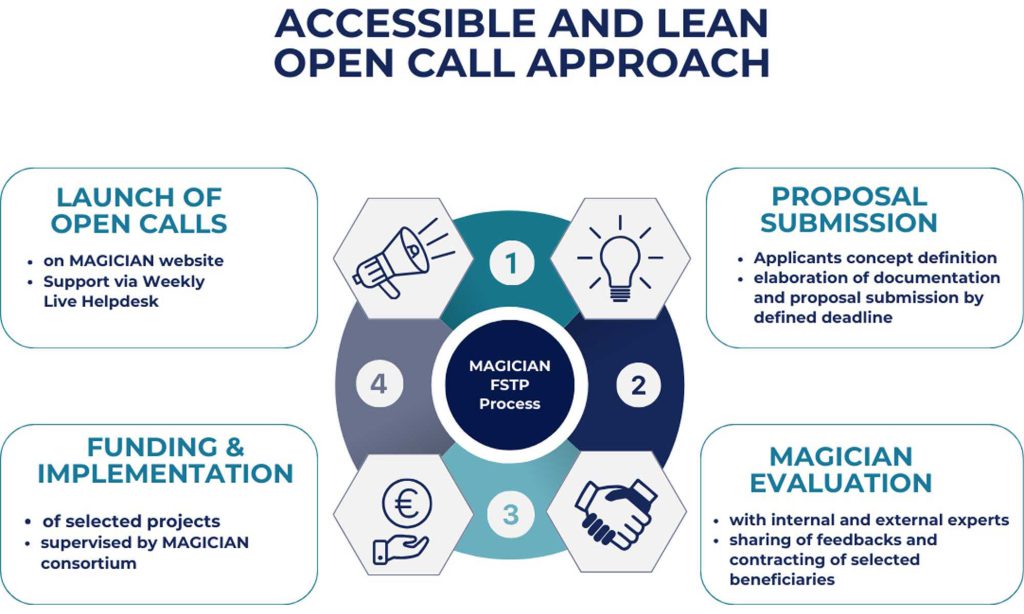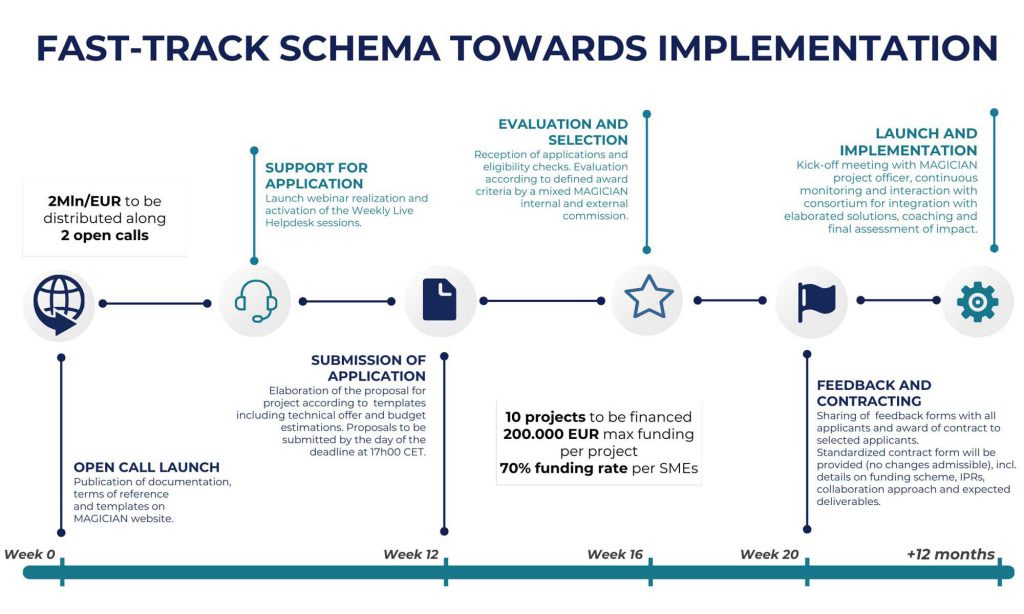Open calls
To expand the scope and application fields of the MAGICIAN solutions, two Open Calls will be launched to select further use cases. This will ensure that the solutions can easily be transferred to other application scenarios and thus prove their generality and replicability.
General Information
The MAGICIAN project will launch two Open Calls to identify and select promising proposals by SMEs / start-ups for experimentation to:
- expand AI applications to new use cases
- deepen and expand functionalities of project pilot (automotive use case)
The two Open Calls intend to:
- fund up to 5 SMEs/start-ups in each call
- distribute up to 2 Mill. EUR of total funding to winning proposals for project implementation ≤ 12 months
- select up to 10 projects for 12 months implementation and 200k/EUR budget
Focus of 1st Open Call
The first open call focuses on the integration of new functionalities within MAGICIAN project solutions through close collaboration with MAGICIAN partners.
The aim is to enhance the capabilities of the SR (Sensing Robot) and CR (Cleaning Robot) through advanced technologies such as
- improved defect detection algorithms,
- more efficient rework techniques, or
- complementary AI modules that optimize their performance in real-time production environments.
Funded projects must provide a solution by focusing on a single module, namely either
- F1 Perception, or
- F2 Human-Robot Collaboration
To support Open Call applicants, a MAGICIAN weekly helpdesk will be open every Wednesday from 17-18:00 (CET).
Join the helpdesk via this link.
Focus of 2nd Open Call
Experiment and expansion of the Use Cases of the MAGICIAN prototype and the extension of the functionalities to new and complementary fields of application towards new Use Cases.
Who can apply
If you are a
- SME according to EU recommendation 2003/361 and related parameters, or
- Start-up
from an EU Member State including overseas departments or the Horizon Europe associated countries.
we are looking forward to receiving your proposal.
Why you should apply
MAGICIAN offers you:
- up to 200,000 EUR funding
- innovation management support
- technical support with expertise on engineering integration with focus on:
- Testing and validation support
- Engagement in Cutting-Edge Technology
- Contribution to Industry Innovation
- Solving Real-World Challenges
- Involvement in Human-Centred Design
You are currently viewing a placeholder content from YouTube. To access the actual content, click the button below. Please note that doing so will share data with third-party providers.
More InformationFAQs
Which activities qualify for financial support?
The activities that qualify for financial support to third parties are explained in Section 1. Objectives of each call for proposal’s Terms of Reference.
How much funding can I expect and which costs are eligible?
The MAGICIAN financial support scheme (FSTP) has been structured in 2 open calls that will distribute up to 2M€ of funding to SMEs and startups. Each proposal will have a maximum budget of 200k€. Eligible costs will follow the same rules of Horizon Europe (HE) as per the HE AMGA, and will include personnel, equipment depreciation (for purchase) or renting (i.e. for robots), other and indirect costs.
Regarding staff costs, eligibility is not limited by a specific job position, e.g. staff costs also extend to SME founders.
Can I submit multiple applications?
Multiple applications can be submitted but maximum one proposal will be funded per each Open Call per beneficiary.
What requirements do I have to fulfil as an applicant?
Each applicant needs to comply with eligibility requirements in terms of size of the applicant (SME/start up) and location (legal entities from EU Member States), as well as submitting a proposal coherent with the scope and requirements (templates) specified in the terms of reference of each call.
What are the evaluation criteria applied in the selection process?
The evaluation criteria is based on a technical evaluation per call done by 3 sub-contracted external experts, who will score all the submitted applications based on the defined criteria of Excellence, Impact and Quality.
A business case evaluation will be done through an interview process as private investors do in their own selection process.
Finally, there will be a global evaluation performed by the MAGICIAN evaluation committee (one representative of each MAGICIAN partner) based on the results of the technical and business case evaluation.
What are the Open Call dates?
Two rounds of calls are foreseen to be launched during the MAGICIAN project. The first Open Call will run from 3rd February until 2nd May 2025. The second Open Call will open in December 2025. Exact dates of launch of the open calls might be adjusted for opportunity reasons: all updates will be published with due advance on the MAGICIAN project website.
How long will the call be open?
All Open Call application period will be open for 12 weeks starting from the opening date indicated in the terms of reference of the OC. Submission of proposals will only be possible in the time that the call is open. During this period, a weekly live helpdesk will be put at disposal of perspective applicants for clarifying doubts or specific aspects of the application process.
How can I submit my proposal and where can I find all Open Call documents?
All the open call documents will be available online on the website once the open call is launched (see Resources & Findings | MAGICIAN).
Proposals are submitted through the Application Form opening up when clicking on the “Apply” button on the “Open Call” page.
I discovered an error in my proposal – can I submit it again?
Yes. If you discover an error in your proposal, you can at any time – provided the call deadline has not expired – submit a new version of your proposal in our portal. Only the last version received before the call deadline will be considered in the evaluation.
Can a UK based company submit a proposal and receive cascade funding?
Yes, UK companies can submit a proposal and receive cascade funding.
To that question, the European Commission specifically answers “UK companies remain eligible forgrants and procurement procedures as if the UK was a member state for the entirety of the Horizon 2020 framework programme and previous framework programmes. This also applies for to financial support to third parties according to Article 204 FR (cascading grants), and applies for the duration of H2020 projects.”
Who will decide which advanced technology will an innovative company work with?
The definition of this collaboration is part of the submitted proposal. In order to define the most adequate solution for the proposal, the innovative company can rely on MAGICIAN partner for advice and help to build the proposal. Please contact MAGICIAN consortium through the helpdesk or the MAGICIAN partners.
My company has links to one of the MAGICIAN partners. Can I still apply to the Open Calls?
Your organization will be eligible provided that it does not fall in the definition of affiliated entity for Horizon Europe (see Annotated Model Grant Agreement page 143 and subsequent) https://ec.europa.eu/info/funding-tenders/opportunities/docs/2021-2027/common/guidance/aga_en.pdf
However, pure support/endorsment from a MAGICIAN partner would not constitute an obstruction for participation to the Open Call.
How are SMEs / Startups defined for the Open Call?
The MAGICIAN Open Call follows the definition of SMEs by the European Commission.
With regard to startups, in the Guide for Applicants under the definition table, start-ups are categorized as “Micro-sized enterprises.” startups should have a maximum of five years of existence and possess an official certificate confirming their establishment, issued, for example, by a chamber of commerce. This document must be uploaded together to the proposal file in the application process.
Does the 1st Open Call offer the possibility to explore new use cases?
No, for the 1st Open Call applicants are not expected to explore new cases. For the 1st Open Call, applicants are expected to integrate and enhance functionalities of the robotic solutions already developed within the MAGICIAN project. However, a 2nd MAGICIAN Open Call, set to be published in December 2025, will specifically target the exploration of new use cases.
Should the robots be exclusively collaborative, or will anthropomorphic robots also be considered?
MAGICIAN is not solely considering collaborative robots in principle, however, to increase flexibility and efficiency, the robot should be able to work side by side with human workers. So, to account for safety regulations, collaborative robots are the preferred solutions.
Do you already have an annotation tool (F1.4), or would you prefer an extension of your existing tool?
No, we do not have an automated annotation tool.
Do you have an annotated dataset of defects? If so, how many images, defects, and categories does it include?
The total categories of defects are the following:
- Positive Dents
- Negative Dents
- Welding Spatters
- Material Defects and
- Sealing Residuals.
Each defect also has a different severity (Class A, Class B, Class C) with approximately 8400 frames to annotate. Assuming collecting all data from all partners a very rough estimation on the maximum image number would be 100K Images to be annotated for all defects/severities/exposures/partners.
What exactly are the expectations regarding F1.4 Annotation Tools for Multi-Modal Data?
Given the importance of annotated datasets for training defect detection models, this topic seeks innovative annotation tools tailored for multi-modal data (e.g., polarized imaging, tof measurements and possibly other modalities). Proposed solutions could include semi-automated or AI-assisted annotation frameworks, making it easier to handle large-scale data labeling tasks while maintaining high accuracy and consistency. Proposals may also explore user-friendly interfaces for annotators or tools that generate synthetic data to augment real-world dataset

